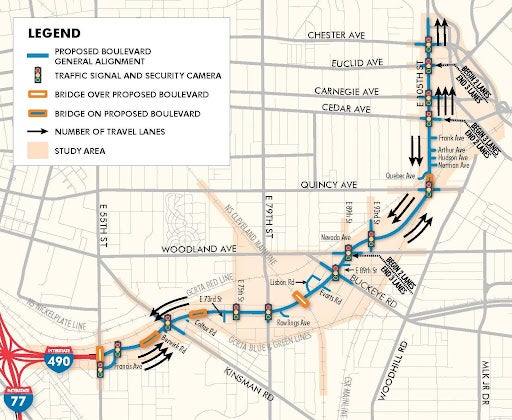OPPORTUNITY CORRIDOR (Oh-10) is a 3.2-mile roadway that connects University Circle with Interstate 490 and runs through largely abandoned industrial areas adjacent to the residential neighborhoods of Fairfax, Kinsman, and Slavic Village. Construction was completed in November 2021 at a cost of approximately $330 million.
During the decade before construction, grassroots and public policy advocates expressed a range of opinions about the proposed project. Some wanted plans to be scrapped entirely. Others urged limiting negative environmental impact, ensuring connectivity of the roadway to the surrounding neighborhoods, or creating jobs accessible to local residents. The aforementioned arguments significantly influenced the project in both its final design and civic commitments to ongoing impact:
- Rather than a typical limited highway design as proposed in previous proposals since the mid-1960s, Opportunity Corridor was engineered as an urban boulevard that retained all cross-street connections (East 105th, Woodland Avenue, Buckeye Road, East 93rd, East 79th, and East 55th) and separated traffic flow with a substantial planted berm. Moreover, a pedestrian/bicycle path parallel to the roadway and fiber-optic wiring were installed along the route.
- The City of Cleveland Planning Commission chose two neighborhoods along Opportunity Corridor (the New Economy & Innovation Square district at East 105th Street in Fairfax and the Core Jobs Zone at East 79th Street in Kinsman) to pilot a form-based zoning approach to future development. This approach to zoning was done in part to deter development types opposed by neighborhood residents, such as polluting industries and undesirable retail outlets.
- Early in the planning process, community development corporations conducted outreach in their neighborhoods to envision ways to leverage benefits for their residents from Opportunity Corridor. Fairfax Renaissance Development Corporation (Fairfax) saw the opportunity to deepen their ongoing partnership with the Cleveland Clinic, the world-renowned medical institution situated on the northern border of the Fairfax neighborhood. (For example, in 2006 Fairfax brokered a land swap for the Cleveland Clinic Cardiovascular Innovation Center in exchange for the renovation of the mothballed Langston Hughes Library Building for use as a Cleveland Clinic neighborhood health center.) Fairfax also sought to develop additional mixed-income housing and add retail, particularly a full-service grocery. Much of this vision was put forth by Fairfax in their 2014 strategic plan for their ‘New Economy Neighborhood.’ Burten Bell Carr Development Corporation in the Kinsman neighborhood south of the Corridor hoped to leverage the new road to retain anchor food manufacturers, including Micelli Cheese Co. and Orlando Bakery, and to protect community gardening and ongoing efforts to promote healthy eating through its Cornucopia Community Teaching Kitchen and Mobile Produce Van, Rid-All Farm and Box-Stop retail project featuring
Concurrent to working with the Ohio Department of Transportation on the many details of the road project, the neighborhood-based community development corporations worked with a wide array of partners – the City of Cleveland, Cuyahoga County, JobsOhio, local philanthropy, the Cleveland Clinic, Fund for Our Economic Future, Cuyahoga County Land Bank and Greater Cleveland Partnership among them – to advance specific projects along the corridor. In the years immediately following the road opening, a number of these projects along the corridor came to fruition. These include:
- Fairfax Market, a 40,000 square foot Meijer’s grocery store at E. 105th Street that eliminates a food desert on the city’s east side;
- a 156,000 cold storage facility at E. 75th Street that enables the approximately 20 food processing businesses in Northeast Ohio, including neighborhood anchors Orlando Bakery and Micelli Cheese, to avoid shipping products to the Columbus, Ohio area for deep freeze storage; and
- a 182,000-square-foot warehousing facility on East 55th immediately south of the corridor that replaced a scrap metal dealer and tire recycling yard on that 11-acre site.
These three projects alone produced dozens of jobs available and accessible to nearby residents.
These same partners continue to plan and invest in ways that further leverage Opportunity Corridor for community benefit. In 2023, the City of Cleveland established the Site Readiness for Good Jobs Fund to facilitate site acquisition and brownfields cleanup in Cleveland, including along the Corridor. The City of Cleveland deployed $50M of its remaining federal ARPA allocation to the fund and set a goal of raising an additional $50M from other sources. The City also hired an experienced professional to work in its Department of Economic Development to coordinate land redevelopment – especially City-owned parcels - around Opportunity Corridor. In early 2024, the Fund for Our Economic Future was awarded a $500,000 Recompete Strategy Development Grant from the U.S. Department of Commerce Economic Development Administration to develop child care, public transit access, and job training to help neighborhood residents access and thrive in the jobs created along Opportunity Corridor in the coming years.
By Robert Jaquay, Edited by Dr. Beth Nagy


